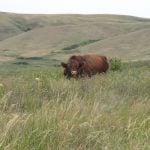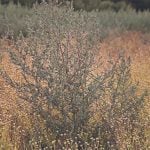The large animal vet shortage in Canada probably isn’t news to you. You may have seen a decline or rapid turnover of vets in your area. The landscape of large animal medicine is changing. What makes large animal medicine appealing to new graduates? And more importantly, what makes vets leave?
Establishing roots
“It’s a very enriching career,” Dr. Mike Krystolovich says of his work as a bovine vet for Upper Grand Veterinary Services in Guelph, Ont.
Read Also

The Canadian Cattle Association’s international advocacy efforts
Global ag policies affect Canadian food policy, so the Canadian Cattle Association participates in international and domestic forums
Krystolovich is a 2014 graduate of the Ontario Veterinary College and was named the Ontario Veterinary Medical Association’s Associate of the Year in 2022. Krystolovich, whose father is a family physician, had originally wanted to be a doctor. Partway through his undergraduate degree, he had a change of heart and decided to pursue veterinary medicine.
“I didn’t know what a cow was until vet school,” Krystolovich jokes. “But you just fall in love with food animal medicine. The farmers are so passionate and humble. Once I started working with cattle, I knew I wanted them to be a part of my daily practice.”
While it is not unusual anymore for large animal vets to grow up outside the agricultural industry, it can serve as a hurdle to overcome for many vets. For Krystolovich, who didn’t come from an agricultural background, the learning curve as a food animal vet was steep at times.
“I feel like it took me a lot of extra steps to get to the point where I could feel competent and talk the lingo,” he says.
Krystolovich’s first job after graduating from vet school was a mixed animal practice in Tillsonburg, Ont. Having grown up in the greater Toronto area, moving to a small town was a culture shock for him. Though southern Ontario is more populated than many other areas of Canada, the surrounding Tillsonburg area is relatively rural. While he lived in Tillsonburg, Krystolovich was a volunteer committee member of the Norfolk Cattlemen’s Association and a regular player in the town’s recreational hockey league. Despite his activity in the community, Tillsonburg never quite felt like home.
“We felt like we could never really fit in. We were always seen as outsiders,” Krystolovich says of his and his wife’s experience living in the small Ontario town. “That was a hard personal barrier to break through.”
After three years as a mixed animal vet in Tillsonburg, Krystolovich accepted a position as a bovine-only vet outside of Guelph, which brought him back to the city where he went to vet school.
Moving to a new community for work is a challenge in any profession. When the community is intimately tied to the profession, as it is in the agricultural industry, a sense of belonging plays hugely into job and life satisfaction. For Dr. Hanna Hone, being welcomed by the community to the Moose Jaw, Sask. area was part of what made her love her job when she moved there by herself to be a large animal vet. Hone moved upon graduation in the spring of 2021 from the Atlantic Veterinary College in Prince Edward Island.
“You’re often attending local events where you know no one, but people know you. The clients are your neighbours and investing in the community actually helped me in practice,” says Hone.
Hone felt that most producers were generally appreciative just to have a vet come out. However, making a more substantial impact on the ranch required trust, which came with its own challenges. “It was a bit intimidating not having any connections or support there prior to moving but being adaptable has always played in my favour when chasing new opportunities.”

Herd work is hard work
If you ask any bovine vet to summarize their career, they will tell you that medicine is a rewarding, although at times challenging, profession.
“The science behind livestock farming is so fascinating. There are so many things on a daily basis that farmers do. They’re accountants, they’re in the fields, they are managing cattle health. I find it very inspiring,” says Krystolovich.
However, bovine medicine, even in a region as populated as southern Ontario, comes with its challenges. The amount of emergency work and on-call requirements, especially for a small practice, can be physically and mentally demanding on vets.
“It can be really hard to sustain a good relationship with someone when you’re always on the road — whether it’s friends, family or navigating a successful marriage,” Krystolovich says. “I think that’s why a lot of people who start out in large animal medicine don’t continue with it.”
Krystolovich comments that the amount of driving required in mobile bovine practice is physically demanding, as sitting for prolonged periods followed by bouts of strenuous or repetitive work can make vets more prone to injuries or developing back problems.
Although the practice he works at is geographically close to several city centres, the service territory is large. The clinic is in the unique situation of having to navigate the challenges of both urban and rural service areas. Vets often have to travel across multiple city centres in one day, which can impede their ability to get to calls quickly, especially during times of increased traffic. In their more rural territory to the north, country roads and highways are frequently closed in the winter because of blowing snow.
Winter conditions and long driving hours are demands faced by almost any large animal practitioner in Canada. In rural areas of the Prairies, drive times can top two hours one way in any direction from the practice. Hone, who grew up with Ontario winters, Arizona summers and the varying climate of Prince Edward Island in vet school, is accustomed to temperature extremes. However, Saskatchewan winters were still a challenge.
“The Saskatchewan winter wind was something I’ve never experienced and really makes me appreciate what kind of conditions my clients and patients are challenged with,” Hone says.
Another tribulation in bovine medicine is the economical limitations of providing many services. The cost associated with providing a service for the vet clinic does not always match the value or return on investment for producers. This can create conflicted feelings for vets, who are driven by the desire to help people and animals but also need to make an income. When they are unable to help an animal or solve a problem, many vets internalize their perceived failures.
“It’s challenging to realize the limitations and realistic application of veterinary medicine,” Hone says.

Commitment to cattle
Why do vets choose to stay in the industry, despite the challenges?
“I love my job, and I appreciate my clients. Beef farming is hard. There are small margins. But there is something special about how much beef farmers love their cattle. That’s a very special thing for me to appreciate as a large animal vet,” Krystolovich says. “As a vet, I still feel like I’m making a difference.”
If there was an aspect of beef cattle medicine that Krystolovich could emphasize to improve job satisfaction, it would be engaging with his beef cattle clients more frequently.
“It can be so useful for clients to establish a relationship with a vet before you’re needed for emergency work because veterinary advice early on can help prevent a lot of problems from happening to begin with. Veterinary involvement can help the producer with management decisions to make the farm more profitable,” he says.
While Hone admits that being a new graduate can be stressful, she wouldn’t change her career path for anything.
“Being patient with myself, trusting the learning process and remembering why I joined the profession in the first place gets me through the tough days,” Hone says. “Things are rarely ‘textbook’ in bovine medicine. No one protocol or treatment is going to be best for every production system. Knowing each client’s individual challenges, budget and goals is what will really make a difference. But that also takes a long time.”
Hone is deeply appreciative of the experiences she has had in Saskatchewan. In September, Hone decided to move back to the East Coast, to be closer to family. She brings her enthusiasm and newly developed skills to Pynn’s Brook, Newfoundland, in her role as a regional large animal vet.
“You have to be willing to put yourself out there and be uncomfortable,” says Hone.
It can be challenging for new vets to find both a community and practice that they fit into. When new vets enter the industry, the culture of the vet practice and the openness of the community can make or break their willingness to stay. Those who want to serve producers and animals will find a way — even if it means moving across the country to find the place where their professional and personal lives can co-exist.
Krystolovich summarizes the career best: “It’s a commitment to a lifestyle and to helping people produce safe food.”
– Dr. Lexie Reed is a food animal veterinarian at Sunny South Veterinary Services in Lethbridge, Alta.
















